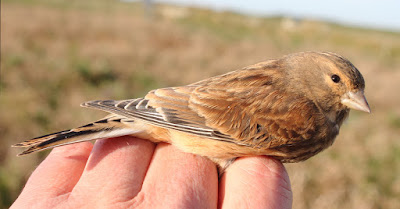The weather has been kind to our recent ringing plans by way of minimal winds and little in the way of rain. It was the same this morning with a forecast of clear skies overnight followed by a light frost and virtually no wind. Andy and I met next to the set-aside plot at Cockerham where Linnets home in each morning to what seems to be a mix well suited to their needs. The forecast proved spot on with a dusting of frost on the crop together with a pretty cold start in the half-light of dawn.
We caught Linnets steadily to the accompaniment of geese calling overhead interspersed with the occasional gunshot. We saw two pinkies drop from the sky this morning. The shooting group along this stretch of Pilling and Cockerham Marsh is Morecambe Bay Wildfowlers. They have a membership of approximately 150 participants whose limit each is shooting on three days a week throughout the winter season. Apparently the club has a waiting list of potential members who might wait four or five years to be accepted, such is the demand for places caused by the vast concentrations of numbers of wildfowl quarry in the winter months.
A typical mid-winter count of the most common wildfowl along this single stretch of coast and dependent on the weather and other factors might be: 8/10,000 Pink-footed Goose, 2,000 Shelduck, 5,000 Wigeon, 1800 Teal, 300 Mallard and 200 Pintail. No wonder the shooters love the place as much as the birders.
Teal
Wigeon
Once again this morning Pink-footed Geese flew off the marsh in almost continuous skeins for at least four hours and a guesstimate of 20,000/30,000 individuals. Many pinkies still arrive from Iceland and the recent mild weather seems to be delaying their onward migration to both Norfolk and south Lancashire.
We heard lots of distant Whooper Swans but less than twenty flew above us with most heading off towards Fluke Hall where more than a hundred have been noted in recent days. As the morning warmed up a good number of waders appeared to feed on the fields nearest the sea wall. We approximated counts of 1000+ Lapwings, 700 Golden Plover, 100 + Curlew and 20+ Redshank.
In the picture below Andy checks the nets in the set-aside crop for Linnets. In the background the bund of the sea wall is visible together with the distant Lakeland fells on the far side of Morecambe Bay and the tall white buildings of Heysham Nuclear Power Station some 15 miles away as the crow flies. Click the pic for a view across Morecambe Bay.
Ringing in the set-aside
We had a pretty good catch of Linnets with another 25 to add to our autumn total plus a new bird for the site in the form of 2 Wrens. In all we saw about 200 Linnets in our stay but we have yet to recapture one out of the 100+ caught in the last 3 weeks. This of course suggests a high turnover of mainly different birds birds rather than the same birds returning each day.
Linnet Ringing Station
Linnet
Wren
Andy seems to have timed his six days in Spain to coincide with a change of weather here in Lancashire as a low pressure system brings winds and more changeable weather. We’ll see.
Log in soon and find out what is happening on Another Bird Blog.
Linking today with http://paying-ready-attention-gallery.blogspot.co.uk/.
Linking today with http://paying-ready-attention-gallery.blogspot.co.uk/.




















































.jpg)












